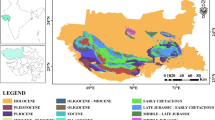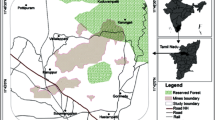Abstract
In the present study, The Landsat 7 ETM satellite data was collected for the Sittampundi anorthosites complex and digital image analysis was carried out. The anorthositic rocks available at Sittampundi complex is considered as an equivalent of lunar highland rocks. Hence, a remote sensing study comprises of image analysis and spectral profile analysis was carried out. The satellite data was digitally processed and generated various outputs like band combinations, color composites, stretched outputs, and PCA. The suitable processed outputs were identified for delineating the anorthosite complex. The diagnostic absorption features of reflectance spectra are the sensitive indicators of mineralogy and chemical composition of rocks, which are interest to the planetary scientists. The spectral profile of Landsat ETM plotted for pure and mixed anorthosite pixels and compared with the field and lab reflectance spectra. The percentages of image spectra vary from 30% to 60% for Sittampundi anorthosite. The spectral bands 2, 4 and 6 have low reflectance and bands 3 and 5 have high reflectance. The spectral range of bands 2,3,4,5 and 6 are 525 nm–605 nm, 630 nm–690 nm, 750 nm–900 nm, 1550 nm–1750 nm and 10400 nm–12500 nm respectively. The field spectral curve has weak absorptions at 650 nm and 1000 nm due to the iron transition absorption and low ca- pyroxene respectively available in the anorthosite, matching with the image spectra. However, hyperspectal image with narrow bandwidth could be more useful in selecting the suitable spectrum for remotely mapping the anorthosite region, as equivalent test site for lunar highland region.






Similar content being viewed by others
References
Adams, J. B. (1974). Visible and near-infrared diffuse reflectance spectra of pyroxenes as applied to remote sensing of solid objects in the solar system. Journal of Geophysical Research, 79, 4829–4836.
Adams, J. B., & Goulland, L. H. (1978). Plagioclase feldspars: Visible and near infrared diffuse reflectance spectra as applied to remote sensing. Proc.Lunar Planetary Science Conference. 9th, pp. 2901–2909.
Anbazhagan, S., & Arivazhagan, S. (2010). Reflectance Spectra of analog Anorthosites; implications for lunar highland mapping. Planetary and Space Science, Elsevier, 58, 752–760.
Arivazhagan, S., Guru Balamurugan, Kusuma, K. N., & Anbazhagan, S. (2009). Spectral reflectance studies of lunar analog rocks: In: S. Anbazhagan, R. Venkatachalapathy & R. Neelakantan (Eds.). Developments in exploration geology and geoinformatics. Macmillan India Ltd, pp. 245–254.
Ashwal, L. D. (2000). Anorthosites. Springer-Verlag Edition.
Bell, P. M., & Mao, H. K. (1973). Measurements of the polarized crystal field spectra of ferrous and ferric iron in seven terrestrial plagioclases. Carnegie Institution of Washington Year Book, 72, 574–576.
Cloutis, E. A. (2002). Pyroxene reflectance spectra: minor absorption bands and effects of elemental substitutions. Journal of Geophysical Research, 107(E6), 5039. doi:10.1029/2001JE001590.
Cheek, L. C., Pieters, C. M., Dyar, M. D., & Milam, K. A. (2009). Revisiting Plagioclase optical properties for Lunar Exploration, 40th Lunar and Planetary Science Conference, 1928.
Crown, D. A., & Pieters, C. M. (1987). Spectral properties of plagioclase and pyroxene mixtures and the interpretation of lunar soil spectra. ICARUS, 72(No. 3), 492–506.
Deering, D. W. (1989). Field measurements of bi-directional reflectance. In G. Asrar (Ed.), Theory and applications of optical remote sensing (pp. 14–65). New York: Wiely.
Geological Survey of India: (2005). Geology map of Namakkal District.
Goetz, A. F. H., Billingsley, F. C., Gillespie, A. R., Abrams, M. J., Squires, R. L., Shoemaker, E. M., et al. (1975). Applications of ERTS images and image processing to regional geologic Problems and Geologic Mapping in Northern Arizona, Rep. Tr 32–1597, Jet. Propul, Lab, Pasadena, California.
Gupta, R. P. (2005). Remote sensing geology (2nd ed.). Berlin Heidelberg: Springer.
Heiken, G., Vaniman, D., & French, B. M. (1991). Lunar source book—A user’s guide to the moon (p. 121). Cambridge University Press: Cambridge.
Lodders, K., & Fegley, B., Jr. (1998). The planetary scientist’s companion (pp. 170–184). New York: Oxford University Press.
Milton, E. J., Rollin, E. M., & Emery, D. R. (1995). Advances in field spectroscopy. In F. M. Danson & S. E. Plummer (Eds.), Advances in environmental remote sensing (pp. 9–32). Chichester: Wiley.
Mitternicht, G. I., & Zinck, J. A. (2003). Remote sensing of soil salinity: potentials and constrains. Remote Sensing of Environment, 85, 1–20.
Ouyang, Z. Y. (1989). Cosmochemistry (p. 93). Beijing: Science Press. In Chinese.
Peterson, C. A., Hawke, B. R., Lucey, P. G., Taylor, G. J., Blewett, D. T., & Spudis, P. D. (1997). Lunar anorthosite: identification and distribution of remnants of the primordial crust. Lunar and Planetary Science, XXVIII, 1608.
Pieters, C. M., & Englert, P. A. (Eds.). (1997). Remote geochemical analysis: Elemental and mineralogical composition (pp. 312–317). New York: Cambridge Univ. Press.
Ramadurai, S., Sankaran, M., Selvan, T. A., & Windley, B. F. (1975). The startigraphy and structure of the Sittampundi complex, Tamil Nadu. ournal of the Geological Society of India, 16(4), 409–414.
Ramasamy, S. M., Venkatasubramanian, V., & Anbazhagan, S. (1993). Reflectance spectra of minerals and their discrimination using Thematic mapper, IRS and SPOT multi spectral data. International Journal of Remote Sensing, 14(16), 2935.
Subramaniam, A. P. (1956). Mineralogy and petrology of the Sittampundi complex, Salem District, Madras state, India. GSA Bulletin, 67(3), 317–389.
Teillet, P. M. (1995). The role of surface observations in support of remote sensing. In E. F. LeDrew, M. Strome, & F. Hegyi (Eds.), Can. J. Remote Sensing Contribution to Understanding Global Change (pp. 333–352). Waterloo: Department of geography Publication Series, No. 38, University of Waterloo.
Zhao, G., & Maclean, A. L. (2000). A comparison of canonical discriminant analysis and principal component analysis for spectral transformation. Photogrammetric Engineering and Remote Sensing, 66(7), 841–847.
Acknowledgement
The authors acknowledge Physical Research Laboratory, Ahmedabad for provided funding through PLANEX programme. The second author acknowledges Tamil Nadu State Council for Science and Technology, Chennai for providing financial assistance to her dissertation work. The corresponding author acknowledges the CSIR, New Delhi for providing SRF fellowship.
Author information
Authors and Affiliations
Corresponding author
About this article
Cite this article
Anbazhagan, S., Sainaba, N.K. & Arivazhagan, S. Remote Sensing Study of Sittampundi Anorthosite Complex, India. J Indian Soc Remote Sens 40, 145–153 (2012). https://doi.org/10.1007/s12524-011-0126-y
Received:
Accepted:
Published:
Issue Date:
DOI: https://doi.org/10.1007/s12524-011-0126-y




